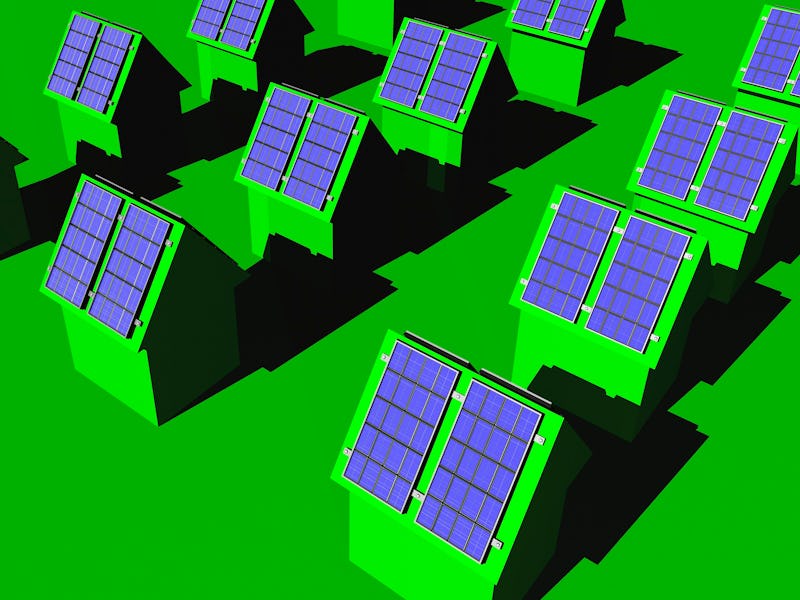For years, scientists have wanted perovskite solar panels. A new coating lets them conduct electricity 10 times better
They could be help everything from energy grids to touch screens.

Researchers at MIT have developed a transparent coating, an organic polymer called PEDOT. That could mean solar panels that are easier to manufacture and make installing on roofs even simpler. The findings were published this month in the journal Science Advances.
“The ability of our vapor deposited conducting polymer layers to integrate into next-generation light-weight solar cells has the potential to simplify the roof top installation process and to reduce the requirement for the total weight the roof can bear,” Karen Gleason, professor of chemical engineering at MIT and one of the paper’s authors, tells Inverse.
It could prove a big step forward for perovskite cells, which could prove a strong alternative to traditional silicon-based solar cells. These cells are easier to manufacture and made from minerals, but large-scale production is difficult and their 24.2 percent record efficiency doesn’t quite reach silicon’s record 26.7 percent efficiency.
Gleason’s team could help improve that. Many panels use indium titanium oxide for protection, but it’s brittle and susceptible to cracking. The team developed a PEDOT alternative two years ago, but it lacked ITO’s transparency and conductivity. The new material is 10 times more conductive than the old one, edging toward ITO levels, and lab tests showed it was able to boost a perovskite cell’s efficiency and stability.
Perovskites have been cited by the International Renewable Energy Agency as one of the technologies that could help solar meet the world’s energy needs. The agency’s report, posted earlier this month, stated that deploying solar alone could reduce carbon dioxide emissions 21 percent by 2050. That would mean solar covers 25 percent of global energy, second only to wind, and could contribute to a 70 percent reduction in carbon emissions from 2020 levels.
As the planet works to reduce emissions, solar advancements could help pave the way.
Solar panels: the race to make panels more efficient
The team’s coating could help make panels more efficient, lighter, and potentially less susceptible to cracking.
Traditional ITO coverings offer high transparency and conductivity, despite its other flaws. When these two factors are measured in Siemens per centimeter, ITO scores around 6,000 to 10,000. The team’s older PEDOT covering scored a value of 50, exceeding their expectations. The newer coating reaches a score of 3,000.
The coating reaches these higher levels with a process called oxidative chemical vapor deposition. This enables a result where the crystals that make up the polymer are aligned horizontally. That, in turn, leads to higher conductivity.
The new material also enables simpler manufacturing. The team was able to process the coating at just 140 degrees Celsius, much lower than alternative coatings.
How much more efficient were these panels? The new version reached 18.04 percent efficiency versus 16.2 percent for the old version. Perhaps crucially though, the new panel retained 76 percent of its initial efficiency 42 days later, versus the old coating that retained just 37 percent of its initial efficiency over the same time period.
From here the goal is to demonstrate its efficiency over a longer time period and under new conditions. Gleason said in a statement that the big hurdle now is more about money: “There’s no technical barrier to moving this forward. It’s really just a matter of who will invest to take it to market.”
Abstract:
For semicrystalline poly(3,4-ethylene dioxythiophene) (PEDOT), oxidative chemical vapor deposition (oCVD) enables systematic control over the b-axis lattice parameter (p-p stacking distance). Decreasing the b-axis lattice parameter increases the charge transfer integral, thus enhancing intracrystallite mobility. To reduce the barrier to intercrystallite transport, oCVD conditions were tailored to produce pure face-on crystallite orientation rather than the more common edge-on orientation. The face-on oriented oCVD PEDOT with the lowest b-axis lattice parameter displayed the highest in-plane electrical conductivity (sdc = 2800 S/cm), largest optical bandgap (2.9 eV), and lowest degree of disorder as characterized by the Urbach band edge energy. With the single step oCVD process at growth conditions compatible with direct deposition onto flexible plastic substrates, the ratio sdc/sop reached 50. As compared to spun-cast PEDOT:polystyrene sulfonate, integration of oCVD PEDOT as a hole transport layer (HTL) improved both the power conversion efficiency (PCE) and shelf-life stability of inverted perovskite solar cells (PSC).